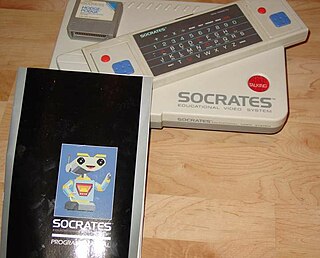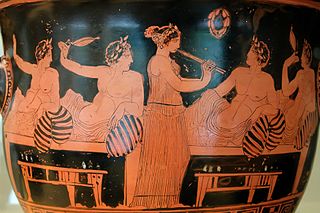
Learning Theory describes how students absorb, process, and retain knowledge during learning. Cognitive, emotional, and environmental influences, as well as prior experience, all play a part in how understanding, or a world view, is acquired or changed and knowledge and skills retained.

Educational entertainment is media designed to educate through entertainment. Most often it includes content intended to teach but has incidental entertainment value. It has been used by academia, corporations, governments, and other entities in various countries to disseminate information in classrooms and/or via television, radio, and other media to influence viewers' opinions and behaviors.
Educational games are games explicitly designed with educational purposes, or which have incidental or secondary educational value. All types of games may be used in an educational environment. Also Educational games are games that are designed to help people to learn about certain subjects, expand concepts, reinforce development, understand a historical event or culture, or assist them in learning a skill as they play. Game types include board, card, and video games. An educational game is a game designed to teach humans about a specific subject and to teach them a skill. As educators, governments, and parents realize the psychological need and benefits of gaming have on learning, this educational tool has become mainstream. Games are interactive play that teach us goals, rules, adaptation, problem solving, interaction, all represented as a story. They satisfy our fundamental need to learn by providing enjoyment, passionate involvement, structure, motivation, ego gratification, adrenaline, creativity, social interaction and emotion in the game itself while the learning takes place.
Situated learning is a theory on how individuals acquire professional skills, extending research on apprenticeship into how legitimate peripheral participation leads to membership in a community of practice. Situated learning "takes as its focus the relationship between learning and the social situation in which it occurs".
Active learning is a form of learning in which teaching strives to involve students in the learning process more directly than in other methods.

Blended learning is an approach to education that combines online educational materials and opportunities for interaction online with traditional place-based classroom methods. It requires the physical presence of both teacher and student, with some elements of student control over time, place, path, or pace. While students still attend "brick-and-mortar" schools with a teacher present, face-to-face classroom practices are combined with computer-mediated activities regarding content and delivery. Blended learning is also used in professional development and training settings.
Collaborative learning is a situation in which two or more people learn or attempt to learn something together. Unlike individual learning, people engaged in collaborative learning capitalize on one another's resources and skills. More specifically, collaborative learning is based on the model that knowledge can be created within a population where members actively interact by sharing experiences and take on asymmetric roles. Put differently, collaborative learning refers to methodologies and environments in which learners engage in a common task where each individual depends on and is accountable to each other. These include both face-to-face conversations and computer discussions. Methods for examining collaborative learning processes include conversation analysis and statistical discourse analysis.
Minimally invasive education (MIE) is a form of learning in which children operate in unsupervised environments. The methodology arose from an experiment done by Sugata Mitra while at NIIT in 1999, often called The Hole in the Wall, which has since gone on to become a significant project with the formation of Hole in the Wall Education Limited (HiWEL), a cooperative effort between NIIT and the International Finance Corporation, employed in some 300 'learning stations', covering some 300,000 children in India and several African countries.
Educational technology is the use of both physical hardware, software, and educational theoretic to facilitate learning and improving performance by creating, using, and managing appropriate technological processes and resources.
A lesson plan is a teacher's detailed description of the course of instruction or "learning trajectory" for a lesson. A daily lesson plan is developed by a teacher to guide class learning. Details will vary depending on the preference of the teacher, subject being covered, and the needs of the students. There may be requirements mandated by the school system regarding the plan. A lesson plan is the teacher's guide for running a particular lesson, and it includes the goal, how the goal will be reached and a way of measuring how well the goal was reached.
Culturally relevant or responsive teaching is a pedagogy grounded in teachers' displaying cultural competence: skill at teaching in a cross-cultural or multicultural setting. Teachers using this method encourage each student to relate course content to his or her cultural context.

The zone of proximal development, often abbreviated as ZPD, is best understood as the zone of the closest, most immediate psychological development of the children that includes a wide range of their emotional, cognitive, and volitional psychological processes. In contemporary educational research and practice, though, it is often interpreted as the distance between what a learner can do without help, and what they can do with support from a knowledgeable adult. The concept was introduced, but not fully developed, by psychologist Lev Vygotsky (1896–1934) during the last three years of his life. Vygotsky argued that a child gets involved in a dialogue with the "knowledgeable other" such as a peer or an adult and gradually, through social interaction and sense-making, develops the ability to solve problems independently and do certain tasks without help. Following Vygotsky, some educators believe that the role of education is to give children experiences that are within their zones of proximal development, thereby encouraging and advancing their individual learning such as skills and strategies.
Developmentally appropriate practice is a perspective within early childhood education whereby a teacher or child caregiver nurtures a child's social/emotional, physical, and cognitive development by basing all practices and decisions on (1) theories of child development, (2) individually identified strengths and needs of each child uncovered through authentic assessment, and (3) the child's cultural background as defined by his community, family history, and family structure.

The Human-Computer Interaction Institute (HCII) is a department within the School of Computer Science at Carnegie Mellon University (CMU) in Pittsburgh, Pennsylvania. It is considered one of the leading centers of human-computer interaction research, and was named one of the top ten most innovative schools in information technology by Computer World in 2008. For the past three decades, the institute has been the predominant publishing force at leading HCI venues, most notably ACM CHI, where it regularly contributes more than 10% of the papers. Research at the institute aims to understand and create technology that harmonizes with and improves human capabilities by integrating aspects of computer science, design, social science, and learning science.
The Consejo Nacional de Fomento Educativo is an institution under Mexico's Federal Government created by presidential decree on 9 September 1971. Its responsibilities are to research, design, implement, operate, and evaluate new educational programs that could increase the education levels among the Mexican population, and could solve the cultural and educational problems of Mexican society.

An educational video game is a video game that provides learning or training value to the player. Edutainment describes an intentional merger of video games and educational software into a single product. In the narrower sense used here, the term describes educational software which is primarily about entertainment, but tends to educate as well and sells itself partly under the educational umbrella. Normally software of this kind is not structured towards school curricula and does not involve educational advisors.

Educational toys are objects of play, generally designed for children, which are expected to stimulate learning. They are often intended to meet an educational purpose such as helping a child develop a particular skill or teaching a child about a particular subject. They often simplify, miniaturize, or model activities and objects used by adults.
Educational psychologists and pedagogues have identified several principles of learning, also referred to as laws of learning, which seem generally applicable to the learning process. These principles have been discovered, tested, and used in practical situations. They provide additional insight into what makes people learn most effectively. Edward Thorndike developed the first three "Laws of learning:" readiness, exercise, and effect.
This page includes some history of video games being used as an additional or alternative method to education. It also goes over whether or not it may be beneficial to use video games for educational purposes in the classroom and the limitations that teachers have to using video games in the classroom. This page additionally discusses how learning from video games outside the classroom is possible as well.
A flipped classroom is an instructional strategy and a type of blended learning that reverses the traditional learning environment by delivering instructional content, often online, outside of the classroom. It moves activities, including those that may have traditionally been considered homework, into the classroom. In a flipped classroom, students watch online lectures, collaborate in online discussions, or carry out research at home while engaging in concepts in the classroom with the guidance of a mentor.











